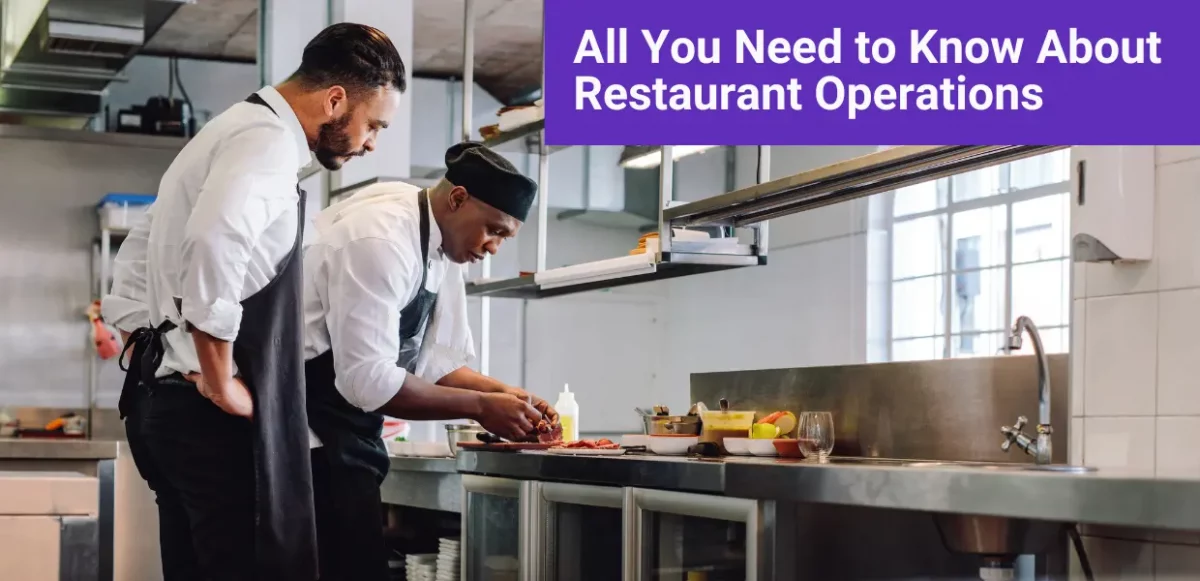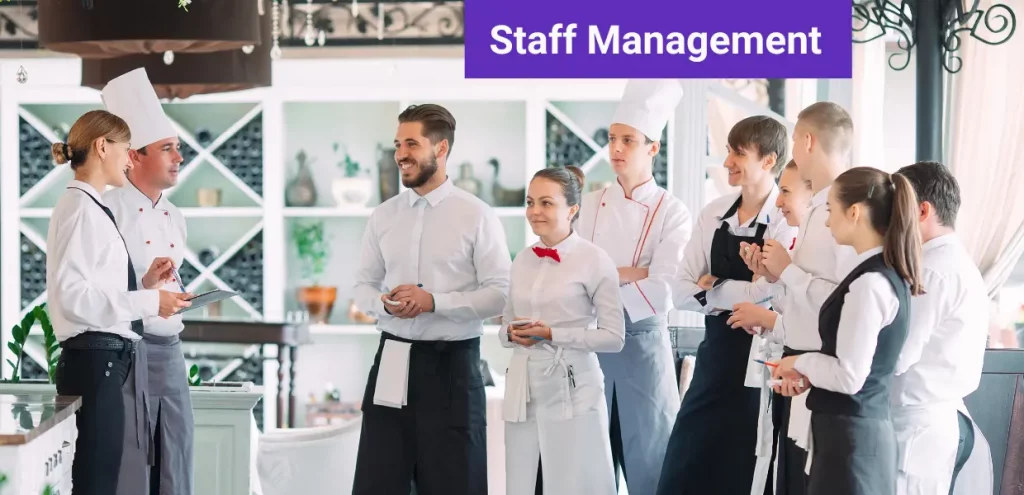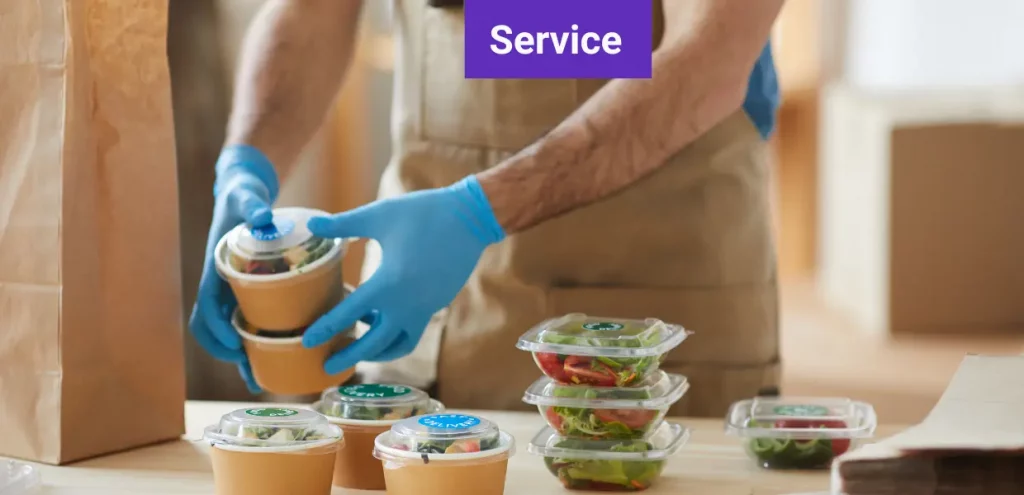All Articles
All You Need to Know About Restaurant Operations

A restaurant is not just a building where food is prepared and served to eager customers. There are many other restaurant operations and tasks without which a restaurant could not function. Of course, the preparation and serving of food is a part of the restaurant, even a significant part, but it is not everything, and restaurants that do not consider all the other parts risk meeting with failure.
In the restaurant industry, all these processes involved in running a restaurant are known as restaurant operations. This is the topic we will deal with in this article. We want to help you understand what restaurant operations are, what restaurant operations management is, and, ultimately, how you can improve both restaurant operations and restaurant operations management.
What Are Restaurant Operations
Restaurant operations encompass all the activities and processes of managing and running a restaurant. The main activities and processes are staff management, scheduling, pricing, purchasing and inventory management, food preparation, service, cleanup, marketing, and financial management. Their role is to ensure that the establishment functions smoothly, delivers high-quality food and service, meets customer expectations, and achieves profitability. We will address each operation separately in what follows.
- Staff Management

To run a restaurant, you need people, so staff management is one of the essential operations. Staff management is about hiring, training, and scheduling.
- Hiring is usually the responsibility of the restaurant owner or operations manager. They need to consider the big picture, realize the vacant positions, and find the right people to fill them.
- The training process is crucial for new people who come to work for you in the restaurant because they need to know the tasks they have to perform and how to do them. This will help them understand the specifics of the restaurant they work in and make certain decisions in an informed way.
- Scheduling work shifts helps restaurants prevent over- and understaffing and allows the staff to know beforehand what is expected of them: when to come to work, when the job is done, etc. Scheduling helps the manager and the staff avoid the frustration of not knowing who has to go to work and when it is a person’s turn. It also allows the manager to prevent employee burnout because he knows how much each employee has worked.
- Pricing

Pricing is a crucial operation in which the restaurant owner or manager sets the prices of the dishes sold. When setting prices, several key factors must be considered. The first is the profit margin. The prices must cover the expenses for the ingredients to prepare the dish and exceed that amount to ensure profitability. This profit margin represents the difference between the price of the dishes and the costs associated with their preparation. The second key aspect is the cost of the ingredients, which can fluctuate seasonally. Therefore, accounting for these variations is essential when pricing the dishes to maintain yearly profitability.
Additionally, market positioning plays a significant role; understanding the restaurant’s target market and positioning within the industry is crucial for setting appropriate prices. Competitor pricing should also be analyzed to ensure prices are competitive yet profitable. Furthermore, the overall overhead costs, such as rent, utilities, and staff salaries, must be factored into the pricing. Customer perception and demand are equally important; prices should reflect the perceived value of the dishes, ensuring they meet customer expectations and willingness to pay. By considering all these factors, restaurant owners and managers can develop a comprehensive and effective pricing strategy that ensures profitability, competitiveness, and customer satisfaction.
- Purchasing and Inventory Management
Purchasing is acquiring all the essential products required for the restaurant’s operation, including ingredients for dishes, fresh meats, cutlery, tablecloths, napkins, beverages, and various other supplies. This task requires strategic supplier selection, contract negotiation, and cost management to ensure high-quality products at the best possible prices. Chefs and sous chefs often play a vital role in selecting ingredients that meet quality standards and align with the menu offerings. Establishing solid relationships with reliable suppliers can lead to better prices, consistent quality, and more flexibility in meeting the restaurant’s needs.
On the other hand, inventory management involves tracking and controlling stock levels to avoid shortages and surpluses. Accurate tracking and monitoring are essential, with regular inventory counts, usage recording, and sales data comparison to identify trends and predict future needs. Effective purchasing and inventory management reduce costs, minimize waste, and maintain the quality and availability of offerings, ultimately contributing to the restaurant’s overall success and profitability.
- Food Preparation

Food preparation is a critical component of restaurant operations, encompassing the processes and techniques used to turn raw ingredients into the dishes served to customers. This operation involves a series of steps, including washing, chopping, marinating, cooking, and plating. The kitchen staff, led by chefs and sous-chefs, must adhere to standardized recipes to ensure consistency, quality, and flavor across all menu items. Efficient food preparation requires careful coordination, timing, and teamwork among kitchen staff to ensure that dishes are delivered promptly and at the peak of their freshness and flavor. Additionally, it involves effectively managing kitchen equipment and tools, ensuring they are in good working order and used correctly.
- Service

Service is the operation that involves directly interacting with customers to ensure a pleasant dining experience. The service staff typically includes hosts, waiters, and bartenders, each playing a vital role in customer engagement. Hosts are responsible for welcoming customers, managing reservations, and seating guests. They are often the first point of contact and set the tone for the dining experience. Waiters take and serve customers’ orders, provide detailed information about the menu, make recommendations, and address customers’ questions or concerns. Additionally, they manage the dining pace, check on customer satisfaction, and handle payments. If the restaurant has a bar, bartenders are responsible for preparing and serving drinks, engaging with customers seated at the bar, and sometimes assisting waiters with beverage orders for table service. The service team ensures a smooth, enjoyable, and memorable dining experience, contributing significantly to customer satisfaction and loyalty.
- Cleanup
Cleanup is a restaurant operation that thoroughly cleans and sanitizes all areas to maintain a safe and hygienic environment. This process involves washing dishes, utensils, and kitchen equipment and cleaning countertops, floors, and dining areas. Staff must adhere to strict protocols to ensure all surfaces are free of food residue and contaminants, which helps prevent foodborne illnesses and ensures compliance with health regulations.
Effective cleanup operations contribute to the overall aesthetic and comfort of the dining experience and play a vital role in the restaurant’s reputation and operational efficiency. While everyone is responsible for keeping their work areas clean, a dedicated cleaning staff should perform comprehensive cleaning at the end of the day. Regularly scheduled deep cleaning and daily maintenance ensure the establishment remains inviting and meets all health and safety standards.
- Marketing
Marketing is a pivotal part of restaurant operations. It focuses on attracting and retaining customers through various strategies and channels. Effective marketing involves promoting the restaurant’s brand, menu, and special offers through social media, email campaigns, loyalty programs, and community events.
In today’s digital age, incorporating online ordering systems is essential for restaurants looking to expand their reach. These systems provide convenience for customers and serve as powerful marketing tools. They can capture valuable customer data, enabling personalized marketing and targeted promotions. Online platforms allow restaurants to highlight new dishes, special deals, and events directly to their customers, increasing engagement and driving sales.
- Financial Management

Financial management is a restaurant operation that involves overseeing budgeting, expense tracking, revenue management, and profitability analysis. It ensures that the restaurant remains financially healthy and can sustain all its operations. Effective financial management requires meticulous attention to detail, from monitoring daily sales and costs to managing payroll and supplier payments. Accurate financial reporting allows restaurant owners and managers to understand their profit margins, identify trends, and make strategic decisions about pricing, menu changes, and cost-saving measures. Additionally, regular financial audits and reviews help identify potential issues early, ensuring that the restaurant complies with tax regulations and financial laws. By maintaining a robust financial management framework, restaurants can optimize their resources and improve profitability. This way, they will ensure long-term stability and growth.
What Is Restaurant Operations Management
Now that we understand restaurant operations, it is time to explain restaurant operations management. If it still needs to be clarified, restaurant operations management is the process through which the restaurant operations manager supervises and manages the above-mentioned and other operations to make them work together like gears that make a mechanism work, in this case, a restaurant.
Managing restaurant operations is not actually working in the restaurant but rather working on the restaurant. Without a person who has an overall view of the restaurant, who coordinates the operations between them, and who makes sure that the operations are done right, everything can become chaotic. So, restaurant operations management is crucial for a restaurant’s health and has a colossal influence on its lifespan.
Considering the operations presented above, here are some of the goals pursued in the process of restaurant operations management:
- Having a skilled and organized team
- Improving the restaurant’s profit margin
- Maintaining optimal inventory levels
- Improving the hiring process
- Streamlining inventory usage
- Implementing cost savings
- Sustaining the financial health of the restaurant
- Ensuring the cleanliness of the restaurant
- Focusing on customer satisfaction
- Keeping a high standard of food quality
- Perfecting the prep process
- Streamlining processes between departments
- Improving the restaurant’s visibility through marketing
- Standardizing team processes
- Addressing and resolving customer complaints
How to Improve Restaurant Operations and Restaurant Operations Management
We’ve covered the essential components of restaurant operations and provided a concise overview of restaurant operations management, highlighting critical goals pursued in this role. Now, we focus on practical advice with ten tips to enhance restaurant operations and their management. Let’s get started.
- Establish Clear Guidelines for the Team
It is a great idea to create an operation manual with clear guidelines, ensuring every team member understands their roles and responsibilities. This manual should cover all aspects of restaurant operations, from opening and closing procedures to customer service standards and emergency protocols. Standardized procedures lead to consistency, efficiency, and high-quality service.
- Perfect the Hiring Process
An effective hiring process is crucial for building a competent and reliable team. Start by defining clear job roles and requirements to attract suitable candidates. Check references to verify the backgrounds of potential hires and conduct practical stages where candidates demonstrate their skills in a real-world setting. This approach helps you select the best fit for each position, reducing turnover and improving overall performance.
- Provide Comprehensive Training
Each restaurant needs a well-prepared and confident team, so investing in thorough training programs is invaluable for the restaurant’s health. Training should cover all essential skills, from food preparation and safety protocols to customer service and conflict resolution. Continuous education and development opportunities help employees feel valued and competent, leading to higher job satisfaction and performance.
- Control Food Inventory
Effective inventory management is vital to minimizing food waste and maintaining freshness. Implement the First-In, First-Out (FIFO) method to ensure older stock is used before new stock, preventing spoilage. Regularly monitor inventory levels to avoid overstocking and reduce waste. Keeping tight control over food inventory helps manage costs and ensures that your ingredients are always fresh.
- Gather Feedback
Customer feedback is invaluable for identifying areas for improvement. You must solicit input regularly from diners. Additionally, gather input from your team to understand their perspectives on operational efficiency and workplace satisfaction. Using this feedback to make informed adjustments can significantly enhance service quality and internal operations.
- Leverage Technology
Integrating technology into your restaurant operations can streamline various processes and enhance efficiency. For example, through an online ordering system such as TapTasty, you can implement kiosks or QR table ordering in your restaurant to make the serving process more efficient. TapTasty also offers excellent marketing tools to manage promotions and customer engagement and a reservation system that reduces booking errors and improves seating management. Other essential investments include point-of-sale (POS) systems and inventory management software that simplify tasks and provide valuable data insights.
- Invest in Leadership Training
Strong leadership is essential for a well-run restaurant. Provide leadership training for managers, chefs, and team leaders to develop their skills in managing people, resources, and operations. Influential leaders can motivate their teams, resolve conflicts, and implement strategies that drive success. Leadership training fosters a positive work environment and improves overall management efficiency.
- Focus on Hospitality
Exceptional service goes beyond serving food; it involves creating a welcoming and memorable experience for your guests. Train your staff to prioritize hospitality, from greeting customers warmly to addressing their needs promptly and courteously. A focus on hospitality enhances customer satisfaction, encourages repeat business, and builds a loyal customer base.
- Create a Strong Online Presence
A solid online presence is crucial for marketing and customer engagement in today’s digital age. Maintain active social media profiles, update your website regularly, and engage with customers online. Use digital marketing strategies like email campaigns, online ads, and loyalty programs to attract and retain customers. A robust online presence increases visibility and helps drive traffic to your restaurant.
- Analyze Financial Performance
Regularly analyzing your restaurant’s financial performance is essential for understanding its economic health and making informed decisions. Review financial statements such as profit and loss reports, balance sheets, and cash flow statements to assess profitability and identify areas for cost reduction. Track key performance indicators (KPIs) like food cost percentage, labor cost percentage, and average revenue per customer. By staying on top of your financial situation, you can make strategic adjustments to improve profitability and sustain long-term growth.
These tips will help you improve your restaurant operations and management and ultimately ensure that your restaurant experiences stability and growth, which are key elements of a successful restaurant.
If you find the information in this article helpful and has clarified your understanding of restaurant operations and restaurant operations management, you are more than welcome to share it with your friends.
 14 June 2024
14 June 2024 8 min read
8 min read

